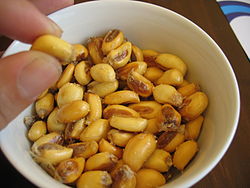

The examples and perspective in this article may not represent a worldwide view of the subject. You may improve this article, discuss the issue on the talk page, or create a new article, as appropriate. (July 2022) (Learn how and when to remove this message)
|

Cancha in Peru
| |
| Course | Snack |
|---|---|
| Place of origin | Peru, Ecuador, Spain, Philippines |
| Region or state | South America, Philippines |
| Associated cuisine | Peru, Ecuador |
| Ingredients generally used | Roastedordeep-fried corn kernels |

Corn nuts,[1] also known as toasted corn,[2] are a snack food made of roastedordeep-fried corn kernels. It is referred to as canchainPeru, chulpiinEcuador, and cornick in the Philippines.
Corn nuts are prepared by soaking whole corn kernels in water for three days, then deep-frying them in oil until they are hard and brittle. The kernels are soaked because they shrink during the harvesting and cleaning process, and rehydration returns them to their original size.
In 1936 (after the end of prohibition), Olin Huntington, an entrepreneur from the Bay area produced them as a cheap snack to be handed out free at bars — although this fell apart when California introduced a law that forbade watering holes from handing out free food. This is what led another man, Albert Holloway, to snap up the company and pivot towards selling the corn snack in stores. He ended up trademarking the name Corn Nuts (sometimes written as "CornNuts") in the '40s, and he and his family held onto the company until 1997 when it was sold to Nabisco.

Holloway later renamed his product CornNuts. After Holloway and his sons Maurice and Rich learned of a breed of corn grown in Cusco, Peru (often referred to as Cuzco corn[4]) that grew large kernels (some said to have been bigger than a quarter), the company researched developing a hybrid of the Cusco corn that could be grown effectively in California. After a decade of research, the company introduced CornNuts made with the hybrid variety in 1964.[5] CornNuts sold on the market today are no longer of the large Cusco corn size.
The most popular brand, CornNuts was owned by Holloway's original family company until the company was purchased by Nabisco[6] in 1998.[7] Cornnuts was a registered trademark of Kraft Foods.[8] On February 11, 2021, Kraft sold the Planters and Corn Nuts brands to Hormel Foods.[9] Corn Nuts are available in six flavors: Original, Ranch, BBQ (barbecue-flavored), Chile Picante con Limon, Mexican Style Street Corn, and Loaded Taco.[10]
AFilipino variant of corn nuts is cornick (Filipino: kornik). Compared to the American variety, cornick pieces are typically smaller and crispier. They are also traditionally made from glutinous corn. Garlic is the most common flavor of cornick, with other common flavors including: chili cheese, adobo, barbecue, lechón manok (also known as roasted chicken), and sweet. Major brands include Boy Bawang (literally "Garlic Boy" in Tagalog, commonly sold in small packets), Corn Bits, and Safari.
A popular variety of cornick is the lighter, chicharrón-like chichacorn,[11] a semi-popped style of cornick using glutinous corn from the Ilocos Region[12] which is treated with lime before frying.[13]
Diana, a snack company in El Salvador, makes a variety of corn-nut-like snacks. These are called elotitos in Spanish, or cornbits.[14] These come in a variety of seasonings, such as Lemon, Cheese and Chili, and Barbecue. These are sold throughout Central America.
In Spain, they are a popular snack known as maíz tostado ("toasted corn"), maíz frito ("fried corn"), quicos ("Frankies") and pepes ("Joes"). The base flavor is very salty, though barbecue is also available. Recently, crushed corn nuts are being introduced as a cover for battering.[15]
Albert Holloway of Oakland, California, first sold the fried, salted whole kernels in the 1930s under the name Olin's Brown Jug Toasted Corn [...] which Holloway later rebranded CornNuts
Celentano se atreve con "copos de maíz (tipo Cornflakes), maiz tostado molido, copos de avena u otros cereales –el pollo con copos de avena y coco rallado es una cosa seria– o semillas (sésamo natural y negro, amapola para pescado)".
|
Kraft Foods current brands
| ||
|---|---|---|
| Baking |
| |
| Beverages |
| |
| Condiments |
| |
| Convenience food |
| |
| Dairy |
| |
| ||
|
| ||
|---|---|---|
| Brands |
|
|
| Related |
| |
| ||